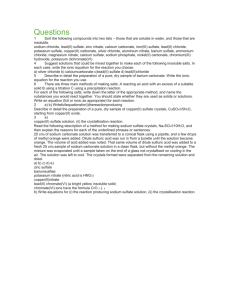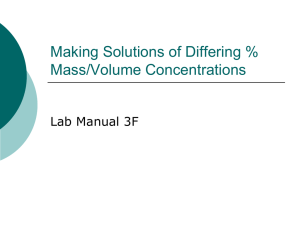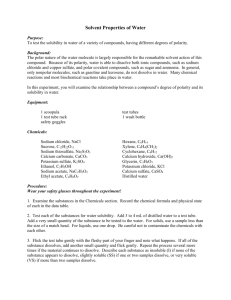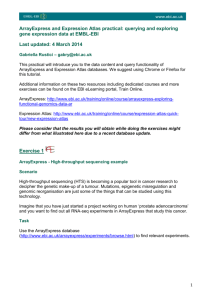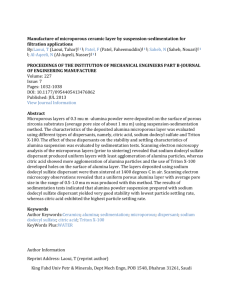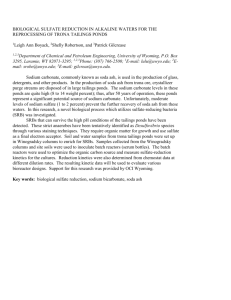Sodium Dodecyl Sulfate
advertisement
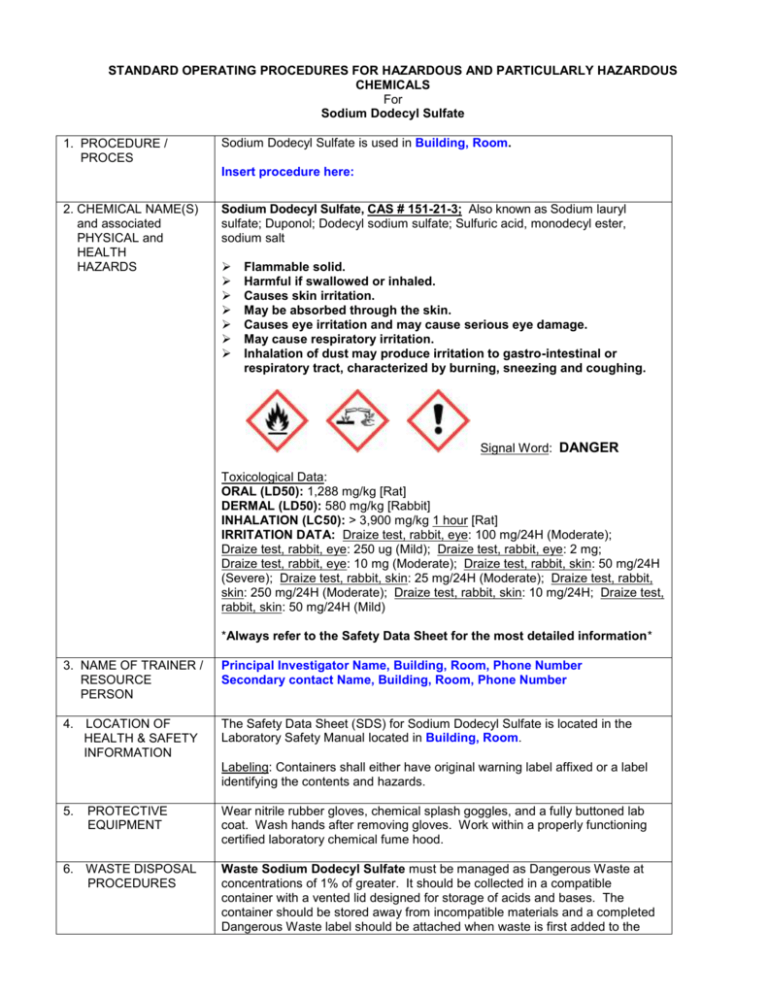
STANDARD OPERATING PROCEDURES FOR HAZARDOUS AND PARTICULARLY HAZARDOUS CHEMICALS For Sodium Dodecyl Sulfate 1. PROCEDURE / PROCES Sodium Dodecyl Sulfate is used in Building, Room. Insert procedure here: 2. CHEMICAL NAME(S) and associated PHYSICAL and HEALTH HAZARDS Sodium Dodecyl Sulfate, CAS # 151-21-3; Also known as Sodium lauryl sulfate; Duponol; Dodecyl sodium sulfate; Sulfuric acid, monodecyl ester, sodium salt Flammable solid. Harmful if swallowed or inhaled. Causes skin irritation. May be absorbed through the skin. Causes eye irritation and may cause serious eye damage. May cause respiratory irritation. Inhalation of dust may produce irritation to gastro-intestinal or respiratory tract, characterized by burning, sneezing and coughing. Signal Word: DANGER Toxicological Data: ORAL (LD50): 1,288 mg/kg [Rat] DERMAL (LD50): 580 mg/kg [Rabbit] INHALATION (LC50): > 3,900 mg/kg 1 hour [Rat] IRRITATION DATA: Draize test, rabbit, eye: 100 mg/24H (Moderate); Draize test, rabbit, eye: 250 ug (Mild); Draize test, rabbit, eye: 2 mg; Draize test, rabbit, eye: 10 mg (Moderate); Draize test, rabbit, skin: 50 mg/24H (Severe); Draize test, rabbit, skin: 25 mg/24H (Moderate); Draize test, rabbit, skin: 250 mg/24H (Moderate); Draize test, rabbit, skin: 10 mg/24H; Draize test, rabbit, skin: 50 mg/24H (Mild) *Always refer to the Safety Data Sheet for the most detailed information* 3. NAME OF TRAINER / RESOURCE PERSON Principal Investigator Name, Building, Room, Phone Number Secondary contact Name, Building, Room, Phone Number 4. LOCATION OF HEALTH & SAFETY INFORMATION The Safety Data Sheet (SDS) for Sodium Dodecyl Sulfate is located in the Laboratory Safety Manual located in Building, Room. Labeling: Containers shall either have original warning label affixed or a label identifying the contents and hazards. 5. PROTECTIVE EQUIPMENT 6. WASTE DISPOSAL PROCEDURES Wear nitrile rubber gloves, chemical splash goggles, and a fully buttoned lab coat. Wash hands after removing gloves. Work within a properly functioning certified laboratory chemical fume hood. Waste Sodium Dodecyl Sulfate must be managed as Dangerous Waste at concentrations of 1% of greater. It should be collected in a compatible container with a vented lid designed for storage of acids and bases. The container should be stored away from incompatible materials and a completed Dangerous Waste label should be attached when waste is first added to the container. When container is full or no longer being used complete a Chemical Collection Request Form, and deliver to the Waste Accumulation Area Operator at Building, Room, Phone Number. If sodium dodecyl sulfate is less than 1% then the solution may be drained discharged. 7. DESIGNATED AREA INFORMATION Sodium Dodecyl Sulfate is stored and used in Building, Room. Sodium Dodecyl Sulfate is used in a proper functioning, certified laboratory chemical fume hood. The designated area(s) should be shown on the floor plan in Laboratories Chemical Hygiene Plan. 8. DECONTAMINATION PROCEDURES Upon Accidental Exposure: In case of eye contact, flush eyes with copious amounts of water at an emergency eyewash station for at least 15 minutes and seek medical attention. In case of skin contact, flush skin with copious amounts of water for 15 minutes and seek medical attention. For exposure over a large portion of the body, remove clothing and shoes and rinse thoroughly in an emergency shower for at least 15 minutes and seek medical attention. In case of inhalation, move person to fresh air and seek medical attention. In case of ingestion, immediately seek medical attention and follow instructions on SDS. Upon Accidental Release: Large Spill: If a large amount of sodium dodecyl sulfate is released outside the fume hood, immediately evacuate, secure the area and call 911 to contact EH&S. Small Spill: If a small amount of sodium dodecyl sulfate is released (it can be cleaned up in 10 minutes) and you are appropriately trained to clean up the spill, you may do so. Use appropriate PPE including nitrile rubber gloves, chemical splash goggles, and fully buttoned lab coat. Additional PPE such as respirators may be necessary depending upon material and concentration. (Note: You must be medically cleared, fit tested and enrolled in WSU’s respiratory protection program to wear a respirator). If it is necessary to use a respirator and personnel are not cleared to wear a respirator and not trained to appropriately clean up the spill, the employee should immediately evacuate, secure area, and call 911 to contact EH&S. Use appropriate tools and place material in an appropriate waste disposal container (resealable bag, etc.) and dispose of as hazardous waste (see above WASTE DISPOSAL PROCEDURES). As with all accidents, report any exposure as soon as possible to your Principal Investigator or Supervisor. Additional health and safety information on sodium dodecyl sulfate can be obtained by referring to the SDS or by calling the EH&S Office (335-3041). 9. SPECIAL STORAGE AND HANDLING PROCEDURES Store in a cool, dry, well-ventilated area away from sources of sunlight, heat, sparks, flame, or other sources of ignition. Keep container tightly closed. Material is Hygroscopic. Keep from getting wet. Avoid dust formation. Keep away from incompatibles such as oxidizers. Certification of Hazard Assessment Is this document a certification of Hazard Assessment for the processes identified within? Yes No If yes, provide the name of the person certifying the Hazard Assessment and the date it was performed: ____________________________________________________________________________________ Name Date The location of the Hazard Assessment is indicated in the document preceding this form. Certificate of Employee Training Name of person providing training for employees working with this process: ___________________________________________________________________________________ The following employees have been trained in when, where and how to use selected PPE, the maintenance, limitations and disposal of the PPE selected, and have demonstrated the correct use of the PPE selected on the reverse of this certification. Name Date Trained ________________________________________ _______________________________ ________________________________________ _______________________________ ________________________________________ _______________________________ ________________________________________ _______________________________ ________________________________________ _______________________________ ________________________________________ _______________________________ ________________________________________ _______________________________
